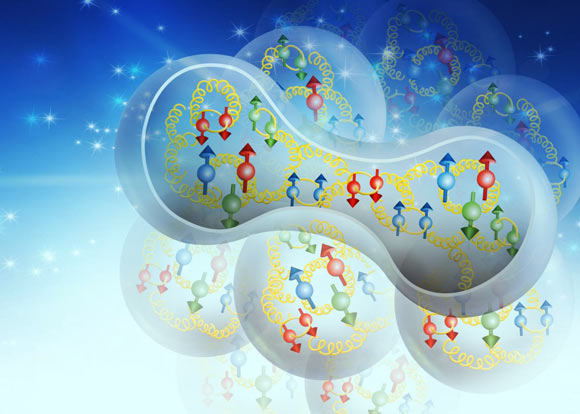The atomic nucleus is made of protons and neutrons, which are themselves composed of quarks and gluons. The latter two are far smaller and operate at much higher energy levels than the protons and neutrons in which they are found. Physicists have therefore assumed that a quark should be blithely indifferent to the characteristics of the protons and neutrons, and the overall atom. But in 1983, the European Muon Collaboration (EMC) at CERN observed what would become known as the EMC effect: in the nucleus of an iron atom containing many protons and neutrons, quarks move significantly more slowly than quarks in deuterium (an isotope of hydrogen containing a proton and neutron in its nucleus). Now physicists from the CLAS (CEBAF Large Acceptance Spectrometer) Collaboration have found that a quark’s speed depends on the number of protons and neutrons forming short-ranged correlated (SRC) pairs in an atom’s nucleus.

Schmookler et al develop a universal function that suggests that proton-neutron pairs in the nucleus, shown here, may be responsible for the EMC effect. Image credit: DOE’s Jefferson Lab.
“There are currently two main models that describe the EMC effect,” said Dr. Douglas Higinbotham, a staff scientist at the Thomas Jefferson National Laboratory and a member of the CLAS Collaboration.
“One model is that all protons and neutrons in a nucleus [and thus their quarks] are modified and they are all modified the same way.”
“The other model, which is the one that we focus on in the study, is different. It says that many protons and neutrons are behaving as if they are free, while others are involved in short-range correlations and are highly modified.”
“An atom’s protons and neutrons can pair up constantly, but only momentarily, before splitting apart and going their separate way,” said Dr. Axel Schmidt, a postdoctoral researcher at MIT.
“During this brief, high-energy interaction, quarks in their respective particles may have a ‘larger space to play’.”
“In quantum mechanics, anytime you increase the volume over which an object is confined, it slows down. If you tighten up the space, it speeds up. That’s a known fact.”
The team analyzed data from an experiment that was carried out at Jefferson Lab’s CLAS detector.
The instrument produced a 5.01 GeV beam of electrons to probe nuclei of carbon, aluminum, iron and lead as compared to deuterium.
The experiment ran for several months and in the end amassed billions of interactions between electrons and quarks.
The physicists calculated the speed of the quark in each interaction, based on the electron’s energy after it scattered, then compared the average quark speed between the various atoms.
By looking at much smaller scattering angles, corresponding to momentum transfers of a different wave length, they were able to ‘zoom out’ so that electrons would scatter off the larger protons and neutrons, rather than quarks.
SRC pairs are typically extremely energetic and would therefore scatter electrons at higher energies than unpaired protons and neutrons, which is a distinction the researchers used to detect SRC pairs in each material they studied.
“We see that these high-momentum pairs are the reason for these slow-moving quarks,” said team member Dr. Or Hen, also from MIT.
In particular, they found that the quarks in foils with larger atomic nuclei (and more proton-neutron pairs) moved at most 20% slower than deuterium, the material with the least number of pairs.
“These pairs of protons and neutrons have this crazy high-energy interaction, very quickly, and then dissipate,” Dr. Schmidt said.
“In that time, the interaction is much stronger than normal and the nucleons have significant spatial overlap. So we think quarks in this state slow down a lot.”
Their data show for the first time that how much a quark’s speed is slowed depends on the number of SRC pairs in an atomic nucleus.
Quarks in lead, for instance, were far slower than those in aluminum, which themselves were slower than iron, and so on.
“Understanding how quarks interact is really the essence of understanding the visible matter in the Universe,” Dr. Hen said.
“This EMC effect, even though 10 to 20%, is something so fundamental that we want to understand it.”
The results appear in the journal Nature.
_____
B. Schmookler et al (CLAS Collaboration). 2019. Modified structure of protons and neutrons in correlated pairs. Nature 566: 354-358; doi: 10.1038/s41586-019-0925-9







